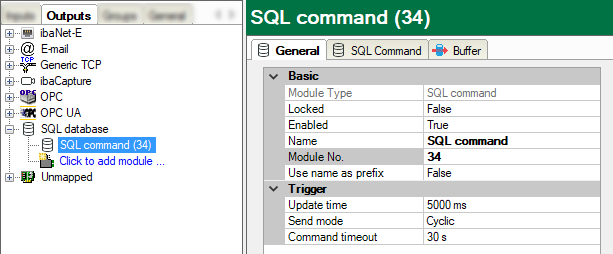The connections to one or more databases are configured and managed with the SQL interface. One or more connections can be configured per database. All DB connections can be used simultaneously. The databases can be of the same or different types.
Database systems from different manufacturers are supported (Maria DB, MySQL, Oracle, PostgreSQL, SAP HANA, SQL Server).
The data exchange with the databases occurs via corresponding SQL modules, which are configured according to the specific database type.
The SQL commands are configured in the Outputs tab. An SQL command module must be configured for each SQL command.
General module settings
For notes on the general module settings see General module settings.
The "Calculation timebase" parameter is not available here.

Trigger
-
Update time In the "Cyclic" send mode, the period in which the command is issued; in the "On change" or "On trigger" send mode, the dead time for suppression of closely successive changes/triggers, if not desired.
-
Send mode- Cyclic: Cyclic sending of the command after the update time- On change: Command is sent when the value of the "Send trigger" signal changes- On trigger: Command is sent when "Send trigger" has a rising edge.
-
Send triggerOnly available with send mode "On change" or "On trigger"Select a suitable signal (analog/digital) with which you want to control the execution of the command.
-
Command timeoutTime limit (in seconds) for the execution of a command. If a command cannot be completely executed within this time after triggering, it is aborted.
SQL command tab
You enter the SQL command in this tab.
Buffer tab
In this tab you can configure a buffer in case the database is not accessible. The memory buffer is always enabled, the file buffer can be additionally enabled and configured.
Commands that could not be executed because the connection to the database was interrupted are stored here and executed sequentially after the connection is restored.
Other documentation |
|
|---|---|
|
A detailed description of the SQL interface and SQL modules can be found in the manual for the corresponding software product:
|
|